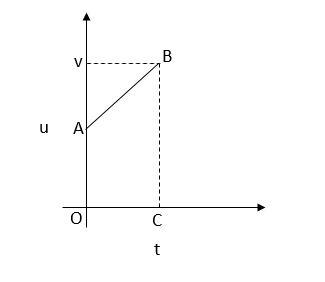
Draw a velocity time graph of a uniformly accelerated motion and derive equation of motion,
$s = ut + \dfrac{1}{2}a{t^2}$from it.
Answer
555.6k+ views
Hint: Velocity-time graph of an object moving with uniform acceleration. When the velocity – time graph is plotted for an object moving with uniform acceleration, the slope of the graph is a straight line, the pattern of slope of the graph shows that object is moving with uniform acceleration.
Complete step by step answer:

In the sequence,
$S$ is displacement,
$u$ is initial velocity,
$t$ is time,
$a$ is acceleration
$V$is final velocity
${V_{av}}$angle velocity
From that,
$av$ velocity ${v_{av}} = \dfrac{{u + v}}{2}$. . . (1)
${V_{av}} = \dfrac{S}{t}$. . . (2)
From (1)
$\dfrac{s}{t} = \dfrac{{u + v}}{2}$ multiply
$ \to S = \dfrac{{\left( {u + v} \right)t}}{2}$. . . (3)
From (2) equation of motion
$v = u + at$. . . (4)
Resulting value of (4) and (3)
$S = \dfrac{{(u + u + at)t}}{2}$
$ \Rightarrow S = \dfrac{{ut + ut + a{t^2}}}{2}$ by separating the equation,
$
S = \dfrac{{2at}}{2} + \dfrac{{a{t^2}}}{2} \\
\implies S = ut + \dfrac{1}{2}a{t^2} \\
$
Additional Information:
Advantage of speed time graph speed-time graphs are very useful when describing the movement of an object. This is a velocity time graph of an object moving in a straight line due to North. The displacement of this object is the area of the velocity time graph. A sloping line on a speed-time graph represents acceleration.
Note:
if an object's speed is increasing at a constant rate then we say it has uniform acceleration; the rate of acceleration is constant. If a car speeds up, then slows down then speeds up doesn’t have uniform acceleration. Non-uniform means that the acceleration is not uniform. Uniform acceleration is change of equal velocity in equal intervals of time. Non-uniform acceleration is change of non-equal velocity in equal intervals of time.
Complete step by step answer:

In the sequence,
$S$ is displacement,
$u$ is initial velocity,
$t$ is time,
$a$ is acceleration
$V$is final velocity
${V_{av}}$angle velocity
From that,
$av$ velocity ${v_{av}} = \dfrac{{u + v}}{2}$. . . (1)
${V_{av}} = \dfrac{S}{t}$. . . (2)
From (1)
$\dfrac{s}{t} = \dfrac{{u + v}}{2}$ multiply
$ \to S = \dfrac{{\left( {u + v} \right)t}}{2}$. . . (3)
From (2) equation of motion
$v = u + at$. . . (4)
Resulting value of (4) and (3)
$S = \dfrac{{(u + u + at)t}}{2}$
$ \Rightarrow S = \dfrac{{ut + ut + a{t^2}}}{2}$ by separating the equation,
$
S = \dfrac{{2at}}{2} + \dfrac{{a{t^2}}}{2} \\
\implies S = ut + \dfrac{1}{2}a{t^2} \\
$
Additional Information:
Advantage of speed time graph speed-time graphs are very useful when describing the movement of an object. This is a velocity time graph of an object moving in a straight line due to North. The displacement of this object is the area of the velocity time graph. A sloping line on a speed-time graph represents acceleration.
Note:
if an object's speed is increasing at a constant rate then we say it has uniform acceleration; the rate of acceleration is constant. If a car speeds up, then slows down then speeds up doesn’t have uniform acceleration. Non-uniform means that the acceleration is not uniform. Uniform acceleration is change of equal velocity in equal intervals of time. Non-uniform acceleration is change of non-equal velocity in equal intervals of time.
Recently Updated Pages
Why are manures considered better than fertilizers class 11 biology CBSE

Find the coordinates of the midpoint of the line segment class 11 maths CBSE

Distinguish between static friction limiting friction class 11 physics CBSE

The Chairman of the constituent Assembly was A Jawaharlal class 11 social science CBSE

The first National Commission on Labour NCL submitted class 11 social science CBSE

Number of all subshell of n + l 7 is A 4 B 5 C 6 D class 11 chemistry CBSE

Trending doubts
What is meant by exothermic and endothermic reactions class 11 chemistry CBSE

10 examples of friction in our daily life

One Metric ton is equal to kg A 10000 B 1000 C 100 class 11 physics CBSE

1 Quintal is equal to a 110 kg b 10 kg c 100kg d 1000 class 11 physics CBSE

Difference Between Prokaryotic Cells and Eukaryotic Cells

What are Quantum numbers Explain the quantum number class 11 chemistry CBSE




